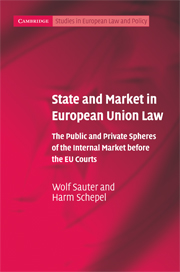 State and Market in European Union Law
State and Market in European Union Law Book contents
- Frontmatter
- Contents
- Acknowledgements
- Abbreviations
- Table of Cases
- 1 Introduction
- PART I Economic activities v. the exercise of public authority
- 2 Free movement: treaty provisions and secondary rules
- 3 The competition rules
- 4 Public constraints on private parties and private constraints on public measures
- PART II The Public Private Interface: Articles 31, 86 and 87–88 EC
- References
- Index
- CAMBRIDGE STUDIES IN EUROPEAN LAW AND POLICY
2 - Free movement: treaty provisions and secondary rules
Published online by Cambridge University Press: 22 January 2010
- Frontmatter
- Contents
- Acknowledgements
- Abbreviations
- Table of Cases
- 1 Introduction
- PART I Economic activities v. the exercise of public authority
- 2 Free movement: treaty provisions and secondary rules
- 3 The competition rules
- 4 Public constraints on private parties and private constraints on public measures
- PART II The Public Private Interface: Articles 31, 86 and 87–88 EC
- References
- Index
- CAMBRIDGE STUDIES IN EUROPEAN LAW AND POLICY
Summary
The interplay of prohibitions and justifications under the free movement rules
The fundamental freedoms are the cornerstones of the internal market, which Article 3(c) EC after all defines as ‘characterised by the abolition, as between Member States, of obstacles to the free movement of goods, persons, services and capital’. The dimension of free movement law that concerns us most directly here is the way in which the Court defines a body capable of taking a ‘State measure’ caught by the free movement rules. However, that issue should be seen in the context of the interplay of two other dimensions: the determination of the kinds ofmeasures that are caught by the free movement rules; and, for measures caught, the definition of legitimate public interest justifications. It appears that the development of these two dimensions is related, and is rather less linear than is often presented. The basic narrative is relatively straightforward: in classic trade agreement fashion the Treaty provisions on free movement of goods, services, workers and capital outlaw discrimination on grounds of origin or nationality. For these kinds of measure, the Treaty provides explicitly circumscribed justifications on the classic grounds of public health, public policy, public security and so on, that the Court interprets narrowly. However, as the Court has taken to demandingmore from State measures than the mere absence of overt discrimination, it has also widened the scope for Member States to invoke legitimate public interest defences for restrictions to the fundamental freedoms. The ambiguity in the story comes from both the historical and substantive divergences in the development of this case law under the different free movement regimes, and from the distractions of Keck.
- Type
- Chapter
- Information
- State and Market in European Union LawThe Public and Private Spheres of the Internal Market before the EU Courts, pp. 29 - 74Publisher: Cambridge University PressPrint publication year: 2009
